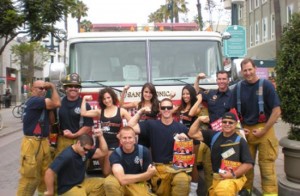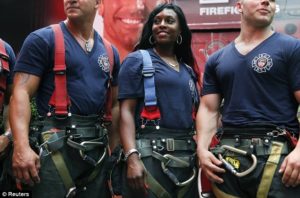By: Robert Avsec, Executive Fire Officer
In response my previous post, What’s Your Plan for an Inclusive and Diverse Department to Increase Service and Safety?, I received a lengthy letter from a fire service colleague that posed several thought-provoking  questions. Below are the contents of that letter. (WK is the letter writer; RPA is me).
questions. Below are the contents of that letter. (WK is the letter writer; RPA is me).
Dear WK,
Thank you for your thought-provoking letter. I read it with great interest and wanted to respond in kind. I thought a discussion by paragraph might be rather interesting.
WK: My question is; We have a proven system of initiation that has worked or has been accepted as the cultural norm for a particular occupation. Who says and what proof do “they” have that this is not the best for our organization?
RPA: I believe in data-driven decision making and data-driven problem solving methodologies. When I “scan” the Fire and EMS “environment” (both on-line and through the several hard copy trade journals I subscribe to) I see far too many instances where our collective “accepted” culture is not working. Just look at the number of lawsuit judgments and settlements; the number of new filings of lawsuits; the numbers of disciplinary actions, including firings, against personnel from firefighter to fire chief that are happening every week across the USA.
 In too many of these cases, the issue is not an objective evaluation of a person’s ability to do the job, but rather someone’s personal and subjective—and in many cases pre-determined—feeling that a person does not belong. That’s not me “talking”, it’s being spoken loudly in millions of dollars (of taxpayer monies) being paid out and jobs being lost.
In too many of these cases, the issue is not an objective evaluation of a person’s ability to do the job, but rather someone’s personal and subjective—and in many cases pre-determined—feeling that a person does not belong. That’s not me “talking”, it’s being spoken loudly in millions of dollars (of taxpayer monies) being paid out and jobs being lost.
When you say, “We have a proven system of initiation that has worked or has been accepted as the cultural norm for a particular occupation” [firefighting], am I to assume that this “system” has been vetted and approved by the leadership of the organizations in question? If that’s the case, then why is money being paid out and people losing their jobs because of the behaviors of individuals towards their fellow employees or members? Is the presence of such a system the best use of taxpayer or contributors monies? Monies that they believe is being used to provide high quality fire protection and EMS?
WK: Does being “sensitive” and implementing procedures actually improve the service to the citizens or is it just a feel good measure?
RPA: In the words of Gordon Graham, “You cannot deliver EXCELLENT external customer service unless you’re delivering excellent INTERNAL customer service.” I firmly believe those sentiments. I have seen first-hand on many occasions the difference in the way the customer (homeowner or medical patient) perceives the care or treatment that they are getting when they see people who “look like them”, e.g., women, people of color, people of different ethnic backgrounds, among the crew that has answered their call for help.
As our communities with the help of immigration attorney serving in NY, continue the “American Tradition” of becoming more diverse with each generation of new immigrants I think it is incumbent that Fire and EMS organizations actively recruit, hire, and retain a diverse membership that is reflective of the communities that they serve. Not only do I think this is it important from a service delivery perspective, it’s also important as a marketing and recruitment tool for organizations to attract good future members from those same communities. People want to be a part of an organization that has incumbent members who “look like them” and share their common experiences and values.
WK: I personally believe we need to return to height, weight and strength charts for our recruits. Simply changing a standard, procedure or job performance requirement to be diverse is a tragedy.
 RPA: I disagree with your first statement and couldn’t agree more with the second. The only acceptable criteria for any recruit firefighter—career or volunteer—to meet should be based upon an objectively developed job description that accurately reflects the job tasks that ALL individuals are required to perform. That’s why the courts have struck down those entrance requirements that do not have a bona fide relationship to the job of a firefighter, e.g., timed distance runs, number of sit-ups, etc. That’s why CPAT was developed by a joint taskforce involving the IAFC (management) and the IAFF (labor).
RPA: I disagree with your first statement and couldn’t agree more with the second. The only acceptable criteria for any recruit firefighter—career or volunteer—to meet should be based upon an objectively developed job description that accurately reflects the job tasks that ALL individuals are required to perform. That’s why the courts have struck down those entrance requirements that do not have a bona fide relationship to the job of a firefighter, e.g., timed distance runs, number of sit-ups, etc. That’s why CPAT was developed by a joint taskforce involving the IAFC (management) and the IAFF (labor).
Changing a standard, procedure, etc., and calling it diversity improvement is akin to painting an old house with a new coat of paint of a different color and calling it a new house. Doesn’t do anything to fix the leaking plumbing or the furnace that doesn’t work.
WK: Why should fire departments be the leader in facilitating cultural change? Does not the changing culture eventually on it own without facilitation find the best solutions? Maybe the fire service is the organization that has the right formulation to find and keep the best personnel for its missions.
RPA: I’m not sure where to start on this one. Ask our citizens of African descent if “change 
We are paid as leaders to lead, guide, and direct the resources of our organizations in the pursuit of a worthwhile and meaningful mission. I see so many Fire and EMS organizations who “spout” the words, “Our people are our most important resources”, and many others like those, and yet they don’t put actions to their words. Our communities are changing (just as they always have) and our mission is changing (as it always has) and successful organizations are going to be those who effectively manage the inevitable changes in their organizations.
WK: Just because someone wants to be a firefighter does not mean they should be. My wife wants to be a NFL Quarterback do you think the NFL should jump through hoops to get her the job and change the locker room behavior to comply to her needs?

Take a trip down to your local recreational facility these days and watch young boys and girls playing together on the same teams, e.g., baseball, soccer, basketball (click this link now), and I think what you’ll see is acceptance and teamwork and camaraderie at work “in spades.” It’s not until adolescence sets in, and society has had a chance to “imprint” those same boys and girls with their “proper roles” in life that many of them get the idea of what they can or can’t be in life.
WK: In fact is that not selfish and self-centered personal behavior that would expect such a change? That does not sound like the person willing to risk their life for someone else. Matter of fact the person that expects and wants these considerations is more likely to be a non-team player. Selflessness is one of the most enduring qualities of the fire service. The person that does not overreact to the ridicule and does not feel embarrassed, threatened or coerced is truly a strong person.
RPA: That first sentence is the definition of a “jackass” and we’ve had them in the fire service 
WK: Diversity in and of itself means not going in the same direction. With an organization like the fire service that depends on it very limited resources and manning (non-pc word) being on the same page is important.
RPA: I disagree with that first sentence. Diversity in an organization consists of recruiting, hiring and promoting a workforce of people with differences. These differences include race, gender, ethnicity, sexual orientation, physical abilities or economic backgrounds. Diversity also consists of creating a culture of inclusiveness, or one where all employees feel valued.
Read more: Importance of Diversity in the Workplace
Our job as leaders is to take all of the knowledge, skills, and abilities that a diverse workforce “brings to the table” and create a culture of inclusiveness where all employees feel valued. It’s also our job as leaders—from the first-line supervisor to the fire chief—to get everyone working in the same direction to accomplish the mission.
We don’t have to look any further than our United States military organizations to see 
See Related: Dignity in the Workplace: It’s a Leadership Thing
WK: Words, like hero. bullying, exceptional, risk, duty and 1000 others have been reduced to commonplace vocabulary words. If we as an organization need sensitivity and diversity training why is the other half of the organization not required to take “toughen-up-and-take-it” courses?
Back to my original question. Who says and what proof do they have that softer, kinder and more inclusionary produces a better more well run organization? Before you start listing them is history on their side?

- Good leaders set standards for the members of their organization.
- Good leaders exemplified through their personal conduct adherence to those standards.
- Good leaders enforced and maintained those standards for the other members of the organization.
- Good leaders demonstrated genuine care and concern for their soldiers, no matter their rank, race, or gender.
Providing respect and dignity in the workplace will do that for you.
Respectfully yours,
Robert
 Fire & EMS Leader Pro The job of old firefighters is to teach young firefighters how to become old firefighters!
Fire & EMS Leader Pro The job of old firefighters is to teach young firefighters how to become old firefighters!